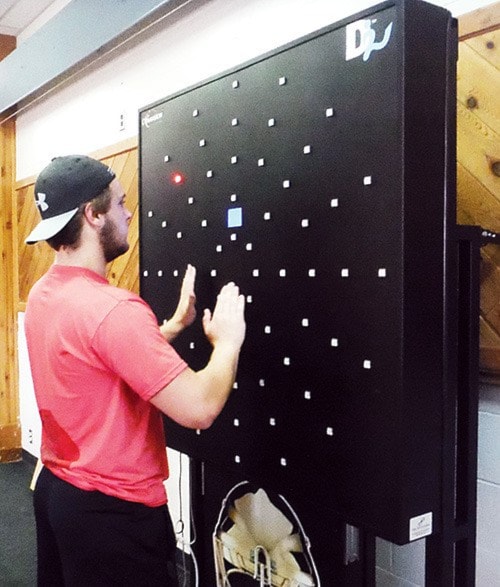Walking into the doors at the Summerland Arena this past week was almost like stepping into a neuroscience lab.
Gold in the Net (GITN) hockey camp for goalies are using the latest technology to enhance performance.
Most people have not experienced a biofeedback machine or visual-motor sensory stimulating machine but these are some cutting edge tools they have brought to town for their camp.
Dynavision has been the secret training weapon for NHL teams for about a decade.
This visual-motor sensory machine helps improve peripheral vision and reaction time under stress. This skill level for a goalie can be a determining factor to make or break their career.
The Dynavision board stands approximately seven feet tall with small lights spaced out over the entire area.
At eye level there is a small blue computer screen for the athlete to stare at while a light flashes in the periphery. The athlete touches the light as quickly as they can while maintaining their eyesight forward, then the next light immediately illuminates.
This fast-paced exercise continues for about a minute.
The machine has the ability to display numbers into the small centre screen which they are to call out while touching the lights for a more dynamic, stressful challenge.
Reilley Elder-Cherry, 17, goalie for the Fort St. John Flyers AA Tier II Midget team explains that after using the machine for a week,
“I feel the difference already. I can read plays better and it helps open up my peripherals. I have better tracking with the puck and it doesn’t seem like it’s coming as fast anymore. It really helps.”
Their goal is to be 0.5 of a second or less for their average reaction time.
It’s no wonder this Dynavision light-training reaction device that was designed for all types of athletes (race car drivers, football players, baseball players), was soon discovered to be a versatile tool for rehabilitation of concussions, brain-injuries, visual field-deficits and even stroke victims.
Bob Simpson, who works with GITN on mental training shows me another tool they are using. He hooks me up to their emWave program by attaching a monitor to my earlobe.
I thought it similar to a biofeedback machine but emWave works with emotions and breathing to monitor coherence levels instead of measuring brainwaves.
Dr. Alan Watkins who lectures on TEDx Talks explains that connecting to our basic physiology (breathing, heart rate) is the foundation that creates a chain reaction to our overall performance.
He explains that the streams of electro signals from inside our body (heart, joints, lungs, digestion etc.) send out streams of data that in turn affect our emotions, feelings, thinking, behaviour and ultimately performance/results. By tuning into our physiology and being aware of our body we are able to learn how to take control of it.
This is important for athletes when they are under pressure.
Bob Simpson explains that the program helps athletes find their own unique ideal performance state and how to stay there amidst distraction and pressure.
Finding your ideal performance state may be a big task, but when starting to learn these skills at 17, this personal awareness may be honed over the next five to 10 years which could help lead them to the sports career of their dreams.
Beyond sports, this technology can help reduce stress, improve health, emotional management and performance wherever their careers and life may take them.
Joanne Malar is the program coordinator for Summerland Recreation, three-time Olympic swimmer, 2012 Olympic Commentator, kinesiologist and holistic nutritionist.
